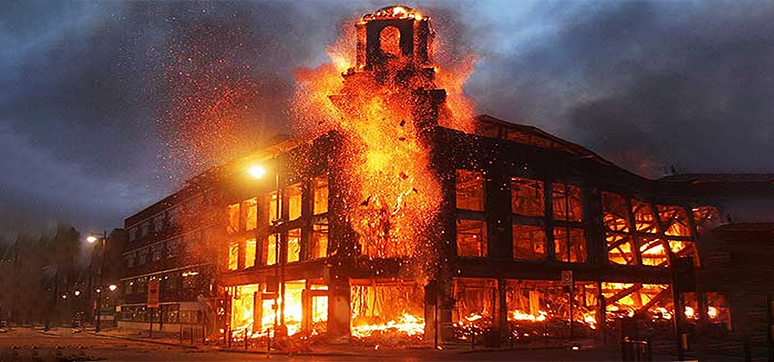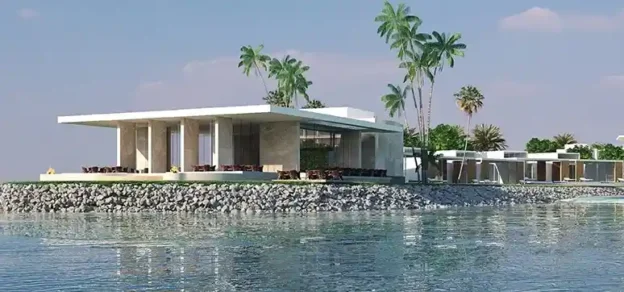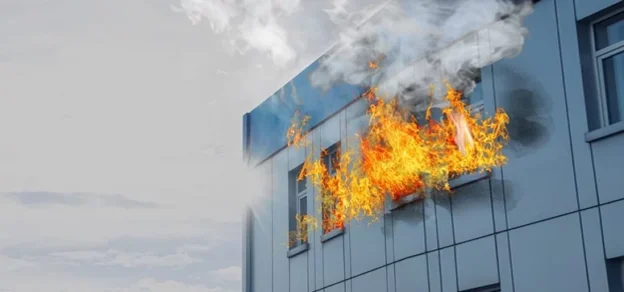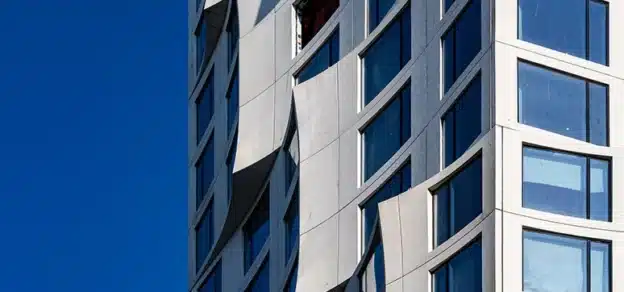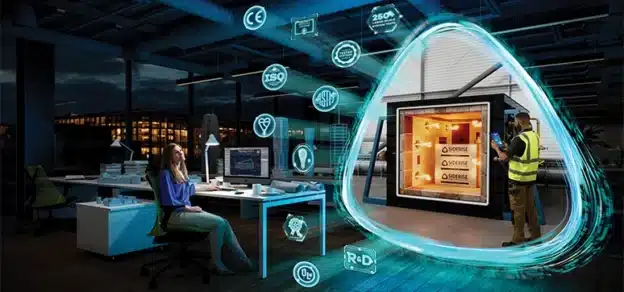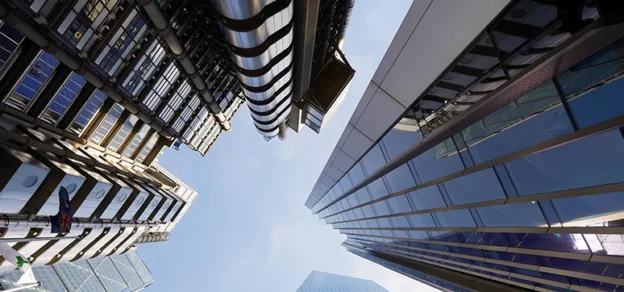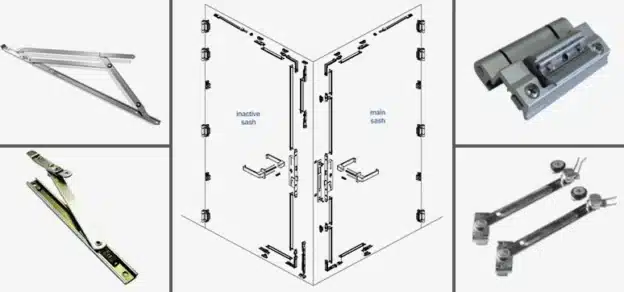The façade of a building is one of its most vulnerable components, particularly in the event of a fire. Aesthetics, cost, energy efficiency, materials, sustainability, and other factors have gotten in the way of considering fire safety precautions. With the relentless growth of high-rise structures, the situation has become more complicated, posing a larger fire hazard. Furthermore, developing tall structures requires a focus on fire safety. In high-rise structures, fenestration and façade design should work together to prevent fire propagation to other portions of the structure through the external flammable cladding. Fire safety design can aid in limiting the spread of a fire as well as limiting smoke and property damage. It also means that buildings are safer for all users.

The story discusses a few common causes of building fire, façade/ fenestration materials’ reactions to fire, parameters defining the performance of a fire retardant façade/fenestration materials, fire resistant building materials, active & passive systems for fireproof façades/fenestrations, fire rating of materials, fire standards and codes, etc.
Common Causes of Building Fires Fire is mainly caused due to faulty or malfunction of cooking equipment, heating equipment, electrical & lighting equipment, and human negligence during interior work, says Shabbir Kanchwala, Senior Vice President, K Raheja Corp.
Explaining it further, Ar. Robin Sisodiya, Principal Architect, ASRO Arcade adds that cookware can easily overheat and catch fire. Portable heaters should be kept at least one metre away from anything that might cause fires, such as furnishings, drapes, laundry, clothes, and even oneself. Electrical dangers can cause fires in homes with inappropriate wiring. If an electrical appliance is defective or has a frayed cord, it might cause a fire. An overloaded switchboard with multiple adaptor plugs can create a fire due to excessive electrical use. If not utilised properly, a power point extension cord can provide a fire hazard.

Lampshades and lighting fixtures can accumulate heat and pose a fire hazard if they are too near to light globes. According to Deanyar Ilavia, Principal Consultant at SAIACON, the main causes in occupied buildings are electrical short-circuits and HVAC equipment malfunction. Mario Schmidt, Managing Director, Lingel Windows and Doors Technologies Private Limited too agrees with Ilavia and adds that faulty wiring, use of cheap substandard materials, and chemical or electrical appliances can cause a fire.
Ar. Ashutosh Jha, Partner, studioAXIS says, case histories have shown that combustible claddings promote the fire spread on façades. According to Jha, smoking is also a major cause. Other than the above-mentioned causes, Ar. Aayush Chaudhary, Principal Architect & Founder, ACad Studio notes that kitchen accidents, gas leaks, heating devices, and negligence too can cause disastrous fires.
A cigarette or a candle too can cause fire, if not properly put out and came into contact with flammable things like furniture. If not handled cautiously, highly combustible liquids such as petrol, kerosene, or mentholated spirits can build a fire, elaborates Sisodiya.

Aravind Chakravarthy V, Head – Codes & Approvals, Business Unit – Fire Protection, Hilti (India) Pvt Ltd lists down the major causes of fire in buildings:
• Electrical short circuit
• Cooking & heating equipment malfunctioning
• Smoking materials such as cigarettes coming in contact with flammable material
• Arson or Intentional fires
• Negligence and human error in handling and storage of flammable materials
According to Ar. Shashi, Space Studio, Chennai, human errors take the number one position while listing the cause for a fire, while lack of supervision and inadequate mechanism of early fire detection and prevention can lead to its spread. Summarising the observations from all experts, Anuj Arya, Veteran Freelancer – Fire Safety & EHS enlists these common causes of building fires as below:
Common Causes of Fire

Electric shock circuit | Spark from oven
Faulty wiring highly combustible liquids
Smoking in bedrooms | Careless throwing of burning cigarettes
Electrical equipment | Naked lamp
Candles Cooking equipment
Curious children | Overheating of electric appliances
Heating Smouldering fuel
Barbeques Misfiring of engine
Flammable liquids | Bursting of the stove
Lighting Burning charcoal
Façade/Fenestration Materials’ Reaction to Fire

Façade and fenestration materials play a critical role pertaining to fire safety in the following ways, lists Anuj Arya:
- Façade and fenestration materials may cause fire to spread throughout the building if these materials are combustible/flammable. They could help propagate the fire from one part of the building to spread to the entire building by the Leapfrog effect apart from adding up to the fire load of the building.
- The façade and fenestration components could generate toxic fumes by virtue of their composition, which gets generated from the burning of façade material. This may result in even more casualties in the event of a fire incident in the building
- The casualties may also occur by means of falling burning debris of these façade and fenestrations components of the building in the event of a fire incident.

The ‘reaction-to-fire’ of façade materials is critical for containing fire spread and carrying out rescue operations, states Sisodiya. When dealing with fire propagation issues, crucial characteristics to examine are combustibility, ignitability, flame dispersion, and burning particles. Furthermore, smoke accumulation and toxicity are essential components of human safety and fire service rescue activities, he adds. The majority of human casualties in a building fire are caused by smoke and toxins.
Agreeing with Sisodiya, Ar. Jha adds that the ‘reaction-to-fire’ of façade materials is very important to contain the propagation of fire and to carry out rescue operations. Ar. Shashi says that materials like wood might have an adverse reaction to a fire being more easily combustible. Glass/metals could heat up and melt or crack into blisters which can cause unpredictable damage during a fire outbreak. Concrete and brick offer an incredible level of resistance to fire.
Talking about glass and aluminium façades, Ilavia observes that when exposed to a fully-developed fire (1200 0 C) on any given floor of a building, the glazing cracks up in about 10~15 minutes and the aluminium framework becomes soft and then burns at about 900 0 C. The fire then “leap-frogs” to the level above after cracking the glass. ACP, unless it is a “Fire Proof” grade not manufactured in India, actively propagates fires. It is best not to use ACP cladding on any structure irrespective of the height.

The most commonly used materials on façades are:
Laminated glass: It is a type of safety glass with an interlayer, mostly Poly vinyl butyl between two or more layers of glass and it doesn’t aid the propagation of fire.
- Interlayered toughened fire glass: Comprises of two or more layers of glass (toughened) with a special intumescent material filled between them and on exposure to fire, it expands on the surface of the glass and does not allow the heat to pass from fireside to the non-fire side.
- Aluminium composite materials: ACM panels with fire retardant PE filler when used with rigid polymeric foam insulation present significant fire hazards when used in building façades. If used, the core must be made self-extinguishing so that it shall not act as a medium for the propagation of fire.
(Aravind Chakravarthy V, Hilti)
Classifications of Materials Based on the Reaction to Fire

To give a full breakdown of the classification, A1 stands for non-combustible materials, A2-non-combustible/ limited combustibility, B, C, and D- range from very limited to medium contribution to fire, and E & F are high contributions to fire. Other than the classification based on combustion, we also consider Smoke Opacity, the ability of a material to not produce fumes, ranging from S1- low opacity and smoke production, S2- medium opacity and smoke production to S3- high opacity to smoke production. \
Another classification that plays an important role in studying the reaction of a material to fire is the flaming droplet/ particle, which is the element’s ability to produce neither droplets nor inflamed particles, divided into D0, which produces drops and particles, D1, produces drops and/or non-inflamed particles and D2, which produces drops and/or inflamed particles. Also, materials aren’t the only contributors to a building’s reaction to fire. The geometry of the façade also affects how the spread of fire can be prevented or caused, horizontal projections, act as flame deflectors whereas vertical projections like a U-shaped façade geometry make it easier for the fire to spread onto other levels of a building.
(Ar. Aayush Chaudhary, Principal Architect & Founder, ACad Studio)
Parameters Defining the Performance of a Fire Retardant Façade/Fenestration Materials

A façade must not propagate fire, it must also not let the fire or heat travel from one area to another and it should not disintegrate in the presence of fire for a reasonable amount of time. To achieve this, an assessment of the whole system performance instead of individual material is to be done, points out Kanchwala. Correct use of products to be incorporated to get desired fire rating of building façade. It calls for proper testing and certification from a third party.
Case histories have shown that combustible claddings promote the fire spread on façades, states Ar. Jha. According to him, the parameters which define the performance of a fire retardant façade are the Extent of lateral & vertical fire spread; extent of smoke emissions; extent of droplet emissions, and self-extinction of the fire on the panel. Arya and Ar. Shashi notes that the crucial parameters that define the performance of a fire retardant façade and fenestration materials are their combustible and toxic (in case of their combustion) properties.
The selection of the façade and fenestration materials should be entirely done keeping in mind these parameters. All other parameters such as aesthetics, economic value, energy-saving, green concept, etc. may be considered considering the fire safety parameters beforehand.

Chakravarthy says that the parameters that define the fire performance of façade materials are Integrity (E), Insulation (I) and Radiation Control (W). There are standards pertaining to the testing of fire rate- glass. Each nation has its code or standards according to which it is tested. “In the current ongoing debate while rating or overrating one product over the other that the fundamental fact needs to be seen to escape the building as quickly as possible. The often highlighted softening point of uPVC at 80 degrees and aluminium at 600 degrees is not going to make anybody’s life safer as a temperature level above 50 degrees is harmful to any individual,” says Mario.
According to Ilavia, the following aspects can prevent damage due to fire:
- Smoke seals – to prevent upward percolation of smoke to the level above. Smoke is the cause of at least 80% of the deaths in hotel and residential building fires.
- Fire-stops – to prevent flames from moving to the level above through the gaps between the building’s slab/ beam and the CW framework.
- Fire-safing of the aluminium framework of curtain wall (CW) spandrels – A one-meter high, fire-safe spandrel will prevent meltdown/burning of the spandrel glass and aluminium framework and delay upward spread of fire by at least 30~45 minutes.
Key Points to Consider while Designing & Installing Fireproof or Fire-Resistant Façades & Fenestrations

Fire safety should be taken seriously at all times, and there are numerous basic measures for reducing the risk of a fire. Fire safety for façades begins during the design stage. The architect, working with other technical disciplines, should ensure that the design aesthetic intent is achieved while retaining the required technical performance, stresses Sisodiya. It is necessary to employ fire-resistant items and technologies. These objects and technologies are usually developed through extensive research and testing. Fire resistance testing should be performed on each component of the façade system, says Sisodiya.
Talking about the design, Mario points out that having buildings without openable windows to reach fresh air and to the fumes to ventilate out of the building are more dangerous in case of fire. Further to this, advanced commercial buildings should have glazing in places which are opening automatically during a fire, so that the smoke/fume can ventilate out of the building to secure those who are inside against the toxic breathing of air as well as to clean the visibility inside the area of the fire brigade, and can have a better view during their operation. Ar. Shashi too insists on sufficient escape possibilities like bay areas, refuge spaces, openable windows, and holding spaces at each floor level.
Ar. Jha advises designing the entire façade system with smoke isolation between floors and elsewhere as required and providing baffles fixed and sealed between the base structure and façade system. He also recommends providing materials and methods of fabrication, installation, and sealing which meet the statutory requirements and using materials that are non-corroding or protected against corrosion, or of such thickness that corrosion will not impair the required fire-stopping or smoke flashing function during the service life of the system. Vertical gaps between different fire compartments shall be filled with an approved fire separation and smoke seal. Fire stops and smoke seals play a crucial role in preventing the spread of fire and smoke and in turn help in minimising fire damage and limiting the casualties, adds Jha.

The aspects to consider and precautions to be taken while designing and installing fireproof or fire-resistant façades and fenestrations are:
- Façade and fenestration materials should not be combustible/ flammable in nature
- The design and the installation of the façade and fenestration components in a building should be such that in no case it would hamper or obstruct the rescue and firefighting operations in the event of a fire incident
- The selection of the façade and fenestration should be carried out considering the toxic properties of the material in case of a fire incident
- The selection of the façade and fenestration material should also be done considering that there should not be any casualties by means of falling of burning debris of the façades and fenestrations of the building in the event of a fire incident.
(Anuj Arya, Veteran Freelancer – Fire Safety & EHS)

Noting down the general requirement of a façade system, Kanchwala points out that it must prove itself to be extremely stable to all external conditions like sunlight, temperature, water, wind, and gravity- faced by high-rise buildings. For overall façade design, the following general parameters should be considered:
- Architectural requirements/ restrictions
- Thermal performance to be achieved (U-value, g-value, layer temperatures)
- Flexibility (adjustable performance)
- Interaction strategy with HVAC systems (extract rate, natural ventilation)
- Meeting the fire safety requirements.
The installation of building façade works at the site requires systematic quality control implemented to avoid any issues post-installation.

Talking about the importance of considering and evaluating the fire characteristics of the façade and exterior wall materials, Chakravarthy from Hilti explains the basic characteristics including evaluation of fire rating, combustibility, flame/smoke spread index, self-ignition temperature and fire propagation. It is important to ensure that the curtain wall system and the perimeter fire barrier system are appropriately designed and installed by the trained and qualified installer in accordance with the engineering drawings adhering to the building code requirements.
According to Ilavia, fire-proof or fire-resistant façades and fenestrations do not exist anywhere in the world. In India, it is best that Hilti or Siderise design the fire-saving system and get an engineering Judgement of the fire-saving design from a certified laboratory (United Laboratories now operate in India) before going ahead with the work.
Fire-Resistant Building Materials

There is a wide range of fire-resistant materials like flame-treated natural products, wherein natural building materials such as lumber and cotton with very poor fire resistance are treated to increase their resistance, making them able to stand up to fire for several minutes, observes Ar. Chaudhary. This type of lumber is used on exterior features to catch the sparks and contain them for an hour before it reaches the interiors of a building. These materials use treated cellulose insulation which acts as flame-resistant by blocking the heat from those flames and also helps keep the building cool in harsh weather conditions.
Talking about materials, Ar. Sisodiya, Ar. Chaudhary and Ar. Shashi lists down the safest few:
Concrete is one of the most effective and popular building materials for slowing down flames since it is heat-resistant and non-combustible. The quantity and quality of aggregate used in the concrete might have an impact on its utility.
Bricks are fire-resistant when used individually. When they’re employed in building, though, the mortar that holds them together has an impact on their fire resistance. Bricks, made in fire kilns are already highly resistant to fire and depending on construction and the thickness of walls, a brick wall usually achieves an hour to four of fire resistance rating.

Gypsum, commonly regarded as drywall, is a non-toxic mineral. When dry drywall comes into touch with fire, it includes chemically mixed water that turns into steam. When mixed with the glass fibres used to produce the board, a high level of fire resistance is achieved. As a result, a gypsum board can significantly improve a building’s fire resistance. Gypsum is the most common fire-resistant interior finish treated with additives to improve its fire-resistant qualities and can deliver a fire rating of up to three hours in the ceiling and as long as four hours in walls and column systems.
Using multiple layers of gypsum board tends to increase its fire-resistance rating. Stucco, made out of Portland cement, sand and lime, used for plasters is an excellent and highly durable fire-resistant finish material, says Ar. Chaudhary; a 1-inch layer of stucco can easily lend a one-hour fire rating to any surface.
Another widely used and extremely common material for façades is fire-resistant glass, says Ar. Chaudhary. An example of fire-resistant glass is dual panel glass, which not only takes double the time to break in case of a fire but is extremely energy efficient too. Another glass material to use in such cases is tempered glass, which is heat-treated and usually about four times stronger than regular glass. It is also wise to note that steel framing provides the best fire protection in the case of such glass.
An intumescent interlayer is designed to seal gaps around penetrations and window frames. They are designed to restrict the spread of fire across the assembly and can have a one to four-hour fire-resistance rating. These adhere to most building materials like gypsum, concrete, glass, metal, etc.

The use of non-combustible and/or class-1 cladding system will make the façade/ cladding materials inherently fire-safe, says Chakravarthy. For the façade system to be deemed safe, it is important to test and ascertain the fire behaviours of the entire façade system which comprises a spandrel and saving insulation, spandrel glass, aluminium frames (transoms & mullions), back pan, anchors, etc.
According to Ilavia, no material except mineral wool insulation, which is currently used in fire stops and façade work spandrel fire-saving, can resist exposure to a fully-developed fire for more than 20 minutes. Jha adds that fire-stop acts like physical barriers, which by design prevent the spread of flames, deadly gases and toxic smoke through openings in buildings. The whole idea of a fire stop is to ensure that fire does not travel vertically to the upper floors of a building through the gaps between the façades and the floor slabs. Elastomeric FireCaulk, says Jha, is a water-based acrylic elastomeric fire-rated caulk that offers excellent fire protection and flexibility, even after full curing.

Smoke and Acoustic Sealant is a high-performance acrylic-based sealant for sealing construction joints and through penetrations in non-fire rated assemblies, adds Jha. It is used for reducing the transmission of sound through wall openings, stopping the passage of smoke in smoke barrier walls, and stopping air leakage to reduce the passage of dust and airborne infectious particles.
Can Glass Be a Fire-Resistant Material?
Fire-resistant glass is frequently overlooked. It looks to be a regular, translucent piece of glass. When a fire breaks out and becomes a life-or-death situation, this specialised construction material provides exceptional resistance to flames, heat, and smoke, and it plays a very significant role in building fire safety.
Standard window glass breaks around 250°F, toughened glass at roughly 500°F, while fire-rated glass may resist temperatures of up to 1600°F. The key cause for this discrepancy is the way it is built. Multiple layers of toughened glass with intumescent interlayers make up fire-resistant glass. When a fire is present, the glass nearest to the flames warms up quickly and shatters into small fragments. The intumescent interlayer is ‘activated’ by this shattering process, causing it to expand and successfully withstand flames, heat, and smoke.
Fire-rated glass creates an effective barrier, separating one room from another and preventing flames from quickly spreading. It reduces the amount of destruction caused and allows time for people to safely escape. These glasses can be used for both internal and external areas, for installation into steel, aluminium or timber frames, partitions, and doors. This type of glass also contributes to preventing the smoke spread.
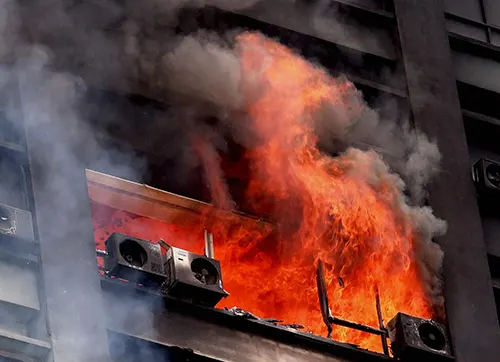
An interlayered toughened glass can hold for 30 minutes and the chances of splinters flying off might be relatively minimal. It can provide protection from radiant heat thereby protecting all the combustible items on the non-fire side from getting ignited on their own. Upon increasing the number of interlayers it can provide complete thermal insulation from heat in addition to integrity of the system. Therefore, using interlayered glass is the best bet to ensure radiant heat resistance (EW rating) and thermal insulation (EI rating) upon the occurrence of fire.
Exterior firefighting and rescue functions benefit from the combined approach of employing fire-resistant glass, implementing installation parameters, and creating openings in the glass façade. I It is widely employed to prevent fire from entering the server and data rooms. The cost of fire-rated glass is the most significant impediment to its use. When a fire compartment is established, fire-rated glass is utilised in the view panels and fire-rated doors in corridors leading to the stairway. As all compartments around are fire-rated, 1-hour fire-rated glass should be placed in the view panel of fire doors.
Active & Passive Systems for Fireproof Façades/Fenestrations
Fire prevention systems are broadly classified into two categories, active fire protection and passive fire protection, and any well-equipped firefighting network should be a synthesis of these two systems.
Passive Fire Protection

Passive fire protection includes fireproofing materials, ensuring that separations of walls, doors, and other openings are created in such a way that smoke and fire cannot transfer for a specific time period, and assuring that building components do not contribute to fire spread. The purpose of this system is to delay the spread of fire by creating barriers to its passage for a specified duration, enabling occupants to assemble in a relatively safer compartment and eventually be pulled out to safety.
Generally, façade design considers the passive design for fire safety. In addition, the design also needs to consider smoke vents in the form of an operable window or actuator for smoke. In a few geographies, it is required to provide ‘fire drenchers’ specifically for high-rise curtain wall buildings. Furthermore, Passive Fire Protection (PFP) systems create compartmentalisation through perimeter fire barriers. The purpose of these systems is to prevent the spread of fire by creating barriers to its passage for a specified duration.
Passive systems utilise fire doors to help further compartmentalise the structure and dampers to prevent the spread of fire and smoke throughout the ducts of the building. Another common protection element in buildings with multiple floors is photo-luminescent path markers. These markers aid in the evacuation process by lighting the way through dark or smoky stairwells. Passive fire protection consists of correctly installed smoke seals, fire stops and fire-saving of the spandrels. Passive fire protection, at best, only delays the spread of a fire.
Active Fire Protection
An active fire protection system refers to anything that requires a certain motion and response in order to stop or combat a fire. They demand a specific action such as making a sound when smoke or heat is detected or releasing fire extinguisher materials when a fire is detected. They can either be automated or manual – for example, a sprinkler system or an extinguisher. These systems require periodic maintenance and audits to verify their workability and response to fire. Some of the active fire protection systems are automatic, such as a sprinkler system, and others may be manual, like a fire extinguisher. Fire alarms, smoke detectors, and even firefighters are all considered active fire protection systems. In general, there are a few different categories of active protection:
- Detection – primarily takes place using sensors that detect heat, smoke, or flame and send a signal to alarms throughout the building.
- Suppression – anything that can put out fire through direct action either manually, such as fire extinguishers, or automatically with indirect or direct release systems.
- Ventilation – keeping evacuation routes smoke-free with fire-resistant fans.
When the BMS receives a smoke signal, fire alarms are automatically switched on, automatic smoke vents open outward and sprinklers and peripheral drenchers get turned on – automatically. This prevents damage to equipment, furniture, and fittings in the occupied spaces of a building. There are various ways to contain/ prevent fire spreads
Prevention: controlling ignition and fuel sources so that fires do not start
Communications: if ignition occurs, ensure occupants are informed and any active fire systems are triggered
Containment: fire should be contained in the smallest possible area, limiting the threat to life safety and the extent of property likely to be damaged
Escape: ensuring that occupants of buildings and the surrounding areas can move to places of safety
Extinguishment: ensuring that fire can be extinguished quickly and with minimal consequential damage
Fire Barriers & Fire Stopping Systems
Fire Barriers

Fire barriers are internal walls that stretch from floor to floor or floor to roof, covering concealed and interstitial spaces. They are intended to partition areas of a building and are supported by structures such as roofs, columns, or floors. Fire barriers slow the initial flow of heat inside the area of origin, giving building inhabitants enough time to evacuate to safe zones. The fire-resistance rating for these walls is usually 2 to 3 hours.
The most common fire barriers systems include the following:
- Firewall: This is a type of wall that resists fire from the exterior of the building. It contains the flames in the area of origin to ensure that it does not spread. The firewall rating will determine how long it can hold fire.
- Fire Partition: These are walls inside a building that subdivide specific rooms and floors. The vertical assembly partitions extend from the floor up to the ceiling.
- Smoke Barrier: It is a type of fire barrier that restricts smoke from spreading. The smoke barriers are either horizontal or vertical. Regardless of the amount of fire, the minimum resistance of the smoke barrier is usually one hour.
Fire Stopping System
Fire stopping is best defined as the sealing of any openings to prevent fire (including smoke and heat) from passing through multiple building compartments. The spread of a fire is contained by creating fire-resisting compartments, which subdivide the building (vertically or horizontally). Buildings must ensure that any openings and gaps are fire-stopped to restrict both lateral and vertical fire spread.
Among the other priorities, fire stopping is essential, which prevents fire/smoke from propagating between floors if the façades are continuous. There are tried-and-true details to follow when using appropriate interface materials. Any compromise in materials, specs, or detailing at this interface would affect fire performance. Fire stopping is a passive fire protection approach that is often built for a 90 or 120-minute fire rating. A firestop is a fire protection system made of various components used to seal openings and joints in fire-resistance-rated wall or floor assemblies. For penetrating cables, they can also be called Multi Cable Transits (MCTs). Firestops are designed to restore the continuous fire resistance of wall or floor assemblies, impeding the spread of fire by filling the openings in them with fire-resistant materials.
(Robin Sisodiya, Principal Architect, ASRO Arcade and Ashutosh Jha, Partner,studioAXIS)
What are Fire Barriers and Fire Stopping Systems?

A fire barrier’s primary purpose is to prevent fire and smoke from spreading. Firewalls, fire partitions, fire check floors, and smoke barriers are commonly used fire barriers. A firestop or fire-stopping is a form of passive fire protection that is used to seal around openings and between joints in a fire-resistance-rated wall or floor assembly. Firestops are designed to maintain the fire resistance rating of a wall or floor assembly intended to impede the spread of fire and smoke, explains Kanchwala.
In curtain wall buildings, the space between the floor and the façades/curtain walls are sealed to prevent the spread of fire. This is called perimeter fire stopping, adds Chakravarthy. The fire stop and the façade must act as an integrated system upon the occurrence of fire.
According to Mario, across the world fire stop doors/fire-stop glazing is usually used ONLY inside the building, and not as external glazing. They are used to protect staircases or different wings/areas of commercial buildings so that the fire cannot progress horizontally within the same floor. For fire protection, two categories are defined: doors stopping the fire & doors stopping the smoke and toxic fumes. The rating starts with 30 minutes of protection and goes up to 90 minutes. Efficiently designed and constructed fire-stop come with a maximum 2-hr rating, says Ilavia.
Fire rating requirements on the façade/ doors/windows and the exterior wall systems – Standards & Codes
Given the boom in the construction of high-rise buildings in the metro cities of India, it becomes imperative for fire rating of façades, doors, windows & external wall systems so that designers can incorporate the same in their designs & the owner of the project is assured about the safety of buildings & products it is offering to the clients.
Fire can be a severe hazard in high-rise structures unless a strategy for orderly and methodical evacuation is in place, fire drills should be held at least once every three months during the first two years after construction. Developers must observe the National Building Code 2005 established particularly for fire and life safety requirements. While absolute fire safety is not achievable in practice, the Code recommends measures that will offer that degree of safety that can be “reasonably accomplished, says Sisodiya.
All buildings must be protected by fire extinguishers, wet risers, automatic sprinkler installations, water sprays, and other means depending on their occupancy, use, and height. For fire rating of doors/window/glazing, the entire product including the installation process should be tested. Frame material/ gasket/locking mechanism/glass used/installation bolts and anchor all need to be taken into account, says Mario.
Correctly designed and installed smoke seals, fire stops and spandrel fire-safing in curtain wall-enclosed buildings is a must. Windows with masonry surrounds cannot be fire safe. However, a 1.60(+)M parapet + beam can delay the upward spread of a fire from the level below by almost 1.5 ~ 2.0 hours, says Ilavia.

To properly protect an opening in a fire-resistance-rated assembly, the proper fire protection rating is required. Determine the required fire-resistance rating of the component under evaluation. Codes, such as NFPA 101, Life Safety Code, NFPA 5000, and Building Construction and Safety Code, should be made mandatory where a building component is required to have a fire-resistance rating. Utilise the tables, “Minimum Fire Ratings for Opening Protectives in Fire Resistance-Rated Assemblies and Fire-Rated Glazing Markings”, found in Chapter 8 of both NFPA 101 and NFPA 5000 to determine the minimum fire protection rating of the opening protective based on the fire-resistance rating determined.
It should be carefully noted that this table DOES NOT mandate the fire resistance ratings of components, other provisions in the Code will require it. Confirm through footnotes, other code text associated with the component, and through occupancy-specific provisions that no further modifications to the general fire protection ratings are permitted. In some cases, there may be exemptions for some opening protectives in existing installations or for certain conditions in some occupancies (Ashutosh Jha, Partner, studioAXIS).
The building codes and NFPA 101, Life Safety Code® require that certain building elements meet minimum fire resistance ratings, such as a 2-hour fire-rated wall or a door, says Arya. In general, fire-resistive installations protect structural elements and separate occupancies and serve as passive fire barriers providing compartmentation, enclosure, subdivision, or protection. Knowledge about the fire rating of the façade cladding materials is important. It helps in choosing the best materials that can ensure optimum fire safety standards for buildings and the protection of the building as well as the occupants, concludes Arya.
Standards for Grading Fire-Resistant Materials
According to Kanchwala, external façade materials like cladding will need to have the classification through an EN 13501 test, e.g. non-combustible, limited combustibility, combustible, etc. Combustible materials should not be used on façades. Resistance to fire needs to be validated using one or more large-scale fire propagation tests of the mock-up of a cladding system like the NFPA 285 or the BS 8414.
Based on the fire properties of different materials, the façade and fenestration materials used in the building are classified as A1, A2, and B.
- A1 Fire Rating Cladding Classification: The cladding materials that fall under the A1 fire classifications are the ones with the highest performance. These materials are non-combustible in nature and have no contribution to fire at all.
A2 Fire Rating Cladding Classification: The construction cladding materials of A2 cladding have limited combustibility properties. They have very limited contribution towards the fire.
B Fire Rating Cladding Classification: These are the no-flashover materials. They are combustible materials that can have a contribution to the fire in your building.
Let’s have a look at the standards for grading fire-resistant materials including glass, ACP, uPVC, etc.
Based on the fire-rating characteristic of a glazed surface, fire-rated glass is categorised into three different types namely,
• Integrity (E)
• Radiation Control (W)
• Insulation (I)
There are many standards pertaining to the testing of fire-rated glass. The most widely followed standards worldwide are the European and the American Standards (namely EN & UL).
The following are the most commonly adopted testing standards for glazed systems:
- EN UL
- EN 1363 UL 263
- EN 1363 UL 10 B
- EN 1634 UL 10 C
In India, British Standards are commonly followed. The test standard BS 476 has been prepared under the direction of the Fire Standards Committee and describes the procedures for determining the fire resistance of elements of building construction. Talking about materials, Mario opines that the retarded characteristics of uPVC or the higher softening point of aluminium are not going to have much -relevance as the first thing during a fire breaks will be the glass. A very critical point in Indian architecture is the use of safety grills and access to stairways or escape routes. In case of a fire, the safety grill can create a deadlock for everyone inside the building with no chance to escape.
Knowing exactly how building materials behave on certain parameters becomes very helpful for façade designers when considering their use to design a building envelope system.
- Ignitability is the ability of a material to be ignited (catch fire) and is Quantified using test methods like ASTM D 1929 (determining ignition temperature of plastics) or BS EN ISO 11925-2(ignitability by direct flame) or EN ISO 1182 (non-combustibility test).
- The chemical composition of a material dictates the amount of latent energy the material has and is Quantified using parameters like Calorific Value and Heat Release Ratio using test methods like BS EN ISO 1716 (gross heat of combustion/calorific value).
- The spread of flame, smoke and other behaviour depends on the composition and distribution of potentially flammable ingredients of a material and is quantified using tests like the ASTM E84 (surface burning characteristics of building materials), BS EN 13823 (single burning item), and many others.
- The European Classification Standard EN 13501-1 provides guidelines for the fire classification of construction products and building elements. Classification using data from reaction-to-fire tests summarises the reaction to fire behaviour clearly.
(Aravind Chakravarthy V, Head – Codes & Approvals, Business Unit – Fire Protection, Hilti (India) Pvt Ltd)
Conclusion
Safety of life is the most important aspect that needs to be factored in during the design of buildings. Forensic studies have indicated that the primary hazard to humans in a building fire is more from smoke and toxic gases. Nearly three-fourths of all building-related fire deaths are from inhalation of the smoke and toxic gases produced in fires rather than from exposure to flame or heat. Appropriate testing of façade materials and the perimeter fire-stopping systems are critical to ensure the adequate performance of the façade system of the building in case of a fire. All fire performance components in a building must function as part of the fire safety strategy. The fundamentals of fire control are prevention and containment.
Systems must be so designed that in case of a fire, it can be contained to the greatest extent possible providing the occupants to escape and limit the spread of fire. Designers must emphasise that true protection comes from a fully certified and tested system/assembly.
